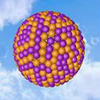| Aug 02, 2024 |
|
(Nanowerk News) Microwave technology has dramatically progressed, marked by the arrival of the 5G era, owing to the advantages of electromagnetic waves in long-distance, wireless, and high-speed transmissions. However, electromagnetic wave pollution problems such as electromagnetic wave interference and electromagnetic wave radiation are becoming increasingly serious.
|
|
Electromagnetic wave pollution not only affects the normal operation of electronic equipment, greatly threatens the information security of the scientific community, but also endangers human health and is a possible cause of cancer and sensitized diseases.
|
|
SiOC precursor ceramics have great application potential in electromagnetic protection because of their advantages such as lightweight, high-temperature resistance, and molecular designability. The main challenge of polymer-derived ceramic-based composites for electromagnetic wave absorption is the single loss mechanism, resulting in inferior electromagnetic wave attenuation ability.
|
|
Although the electromagnetic wave absorption performance of PDC-SiOC ceramic has been considerably improved in previous works, the reported manufacturing processes are complex and require expensive equipment.
|
|
Recently, two teams of material scientists led by Yongqing Wang and Xiaojun Zeng from Jingdezhen Ceramic University, China reported the synthesis of SiOC@C ceramic nanospheres with tunable electromagnetic wave absorption performance by liquid phase method and precursor transformation method. This work not only explains the relationship between atmosphere, phase composition, microstructure, and absorption performance, also obtains the SiOC@C ceramic nanospheres with the minimum reflection loss value of -67.03 dB.
|
 |
| SiOC@C ceramic nanosphere precursor was obtained using a liquid phase method. Then, a series of SiOC@C ceramic nanospheres containing SiC/Si3N4, free carbon, and amorphous SiOC were successfully obtained through rational control of the heat-treatment temperature and atmosphere. Intriguingly, the SiOC@C ceramic nanospheres obtained in the Ar atmosphere exhibited the minimum reflection loss value of -67.03 dB; and the SiOC@C ceramic nanospheres obtained in the N2 atmosphere exhibited the minimum reflection loss value of -62.76 dB. (Image: Journal of Advanced Ceramics, Tsinghua University Press)
|
|
The team published their work in Journal of Advanced Ceramics (“Synthesis of SiOC@C ceramic nanospheres with tunable electromagnetic wave absorption performance”).
|
|
“In this report, we synthesized a series of SiOC@C ceramic nanospheres containing SiC/Si3N4, free carbon, and amorphous SiOC through rational control of the heat-treatment temperature and atmosphere” said Junjie Qian, teacher at School of Materials Science and Engineering at Jingdezhen Ceramic University (China), whose research interests focus on the field of electromagnetic wave absorption material.
|
|
“Although the electromagnetic wave absorption performance of PDC-SiOC ceramic has been considerably improved in previous works, the reported manufacturing processes are complex and require expensive equipment.” said Junjie Qian.
|
|
“The SiOC@C ceramic nanospheres obtained in the Ar atmosphere consisted of SiC nanocrystalline, graphite phase carbon, amorphous carbon, and amorphous SiOC. The RLmin value of SiOC@C-3-30% was -45.23 dB at a matching thickness of 1.5 mm, and its EAB could cover the entire C, X, and Ku bands by adjusting the sample thickness.” said Junjie Qian.
|
|
“The SiOC@C ceramic nanospheres obtained in the N2 atmosphere consisted of Si3N4 nanocrystalline, graphite phase carbon, amorphous carbon, and amorphous SiOCN. The RLmin value of SiOC@C-4-30% was -62.76 dB at a matching thickness of 1.63 mm. The RLmin value of SiOC@C-5-30% was -60.54 dB at a thinner matching thickness of 1.57 mm” said Junjie Qian.
|
|
However, more delicate research works are still needed to explore the antibacterial activity of SiOC ceramics. In this regard, Qian also put forward several major development directions may be pursued in future works including antibacterial activity, antiseptic property and oxidation-resistant property.
|


